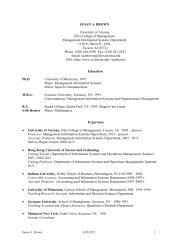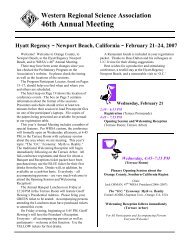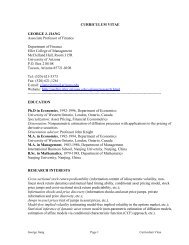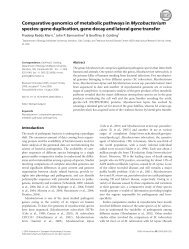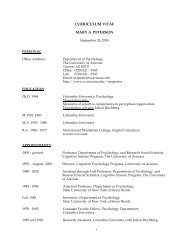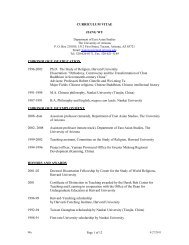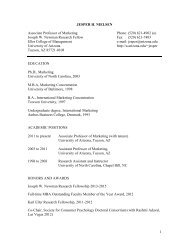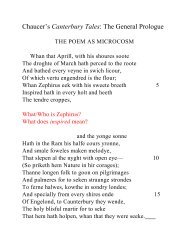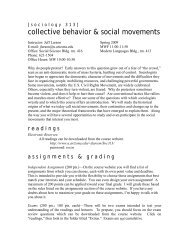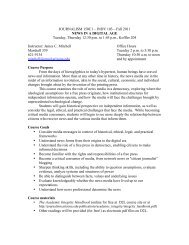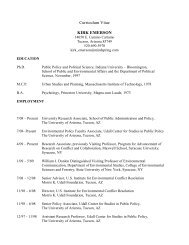Inter simple sequence repeat (ISSR) polymorphism and its ...
Inter simple sequence repeat (ISSR) polymorphism and its ...
Inter simple sequence repeat (ISSR) polymorphism and its ...
You also want an ePaper? Increase the reach of your titles
YUMPU automatically turns print PDFs into web optimized ePapers that Google loves.
15<br />
veloped in various fungi groups using <strong>ISSR</strong>s (Hantula<br />
et al., 1996).<br />
Determining SSR motif frequency<br />
<strong>ISSR</strong> analysis provides insights into the organization<br />
(clustered or not), frequency <strong>and</strong> levels of <strong>polymorphism</strong><br />
of different <strong>simple</strong> <strong>sequence</strong> <strong>repeat</strong>s in a genome.<br />
In rice <strong>and</strong> wheat, di-nucleotide <strong>simple</strong> <strong>sequence</strong> <strong>repeat</strong>s<br />
used as primers gave the maximum number of<br />
b<strong>and</strong>s <strong>and</strong> are, therefore, more common than any SSRs<br />
with larger un<strong>its</strong> (Blair et al., 1999; Nagaoka & Ogihara,<br />
1997). Poly(GA) based 3’-anchored primers produced<br />
5 times as many b<strong>and</strong>s as those with poly(GT)<br />
motif indicating low frequency or lack of clustering<br />
of (GT) motif (Blair et al., 1999). Using <strong>ISSR</strong>s<br />
it has been shown that tetra-nucleotide <strong>repeat</strong>s were<br />
abundant across eukaryotic genomes (Gupta et al.,<br />
1994) <strong>and</strong> that tetramers of tetra-nucleotides AGAC<br />
<strong>and</strong> GACA are scattered within the genome of grasses<br />
(Pasakinskiene et al., 2000). It has been demonstrated<br />
in Brassica that enhanced recovery of microsatellite<br />
markers is possible using <strong>ISSR</strong> primers (Varghese et<br />
al., 2000).<br />
Studies on natural populations/ speciation<br />
The hypervariable nuclear <strong>ISSR</strong> markers have proved<br />
useful in testing hypotheses of speciation, introgression<br />
<strong>and</strong> systematics (Wolfe et al., 1998). The hybrid<br />
origin of Penstemon clevel<strong>and</strong>i was clearly brought<br />
out by the use of just 8 <strong>ISSR</strong> markers. Population of P.<br />
clevel<strong>and</strong>i has been found to have an additive profile<br />
of b<strong>and</strong>s of the two proposed progenitor species viz. P.<br />
centranthifolius <strong>and</strong> P. spectabilis. On the other h<strong>and</strong><br />
the population of P. spectabilis lacked the additive<br />
profile of b<strong>and</strong>s of <strong>its</strong> proposed putative parents. The<br />
hybrid origin of P. spectabilis was thus negated <strong>and</strong> <strong>its</strong><br />
origin was attributed instead to introgression of genes<br />
<strong>and</strong> not the genome of a related species. The utility<br />
of the technique has been demonstrated in a wide<br />
range of applications in molecular ecology in plant<br />
families which include Asteraceae, Brassicaceae,<br />
Hippocastanaceae, Orchidaceae, Poaceae, Scrophulariaceae<br />
<strong>and</strong> Violaceae (http://www.biosci.ohiostate.edu/<br />
∼awolfe/issri.issr.html). Variation within<br />
<strong>and</strong> between populations can be compared using dispersed<br />
multilocus markers such as <strong>ISSR</strong>. It was shown<br />
that the amount of variation between O. granulata<br />
populations from different regions (49.2%) was higher<br />
than that between populations within a region (38%)<br />
or within a population (12%) using <strong>ISSR</strong> markers<br />
(Qian et al., 2001).<br />
Perspectives<br />
As the need to protect proprietary germplasm is likely<br />
to increase in the future, <strong>ISSR</strong>s will have an important<br />
role in securing plant variety rights by virtue of<br />
<strong>its</strong> unique efficiency in distinguishing even closely related<br />
germplasm. To date, more <strong>polymorphism</strong> has<br />
been detected with the use of <strong>ISSR</strong>s than with any<br />
other assay procedure (Gupta et al., 1994; Salimath<br />
et al., 1995; Virk et al., 2000). In many of the studies<br />
for determining the extent of <strong>polymorphism</strong> or comparing<br />
marker systems only one family of SSRs, eg.<br />
tri-nucleotides or tetra-nucleotides had been used as<br />
primers. Such <strong>repeat</strong>s are infrequent as compared to<br />
di-nucleotides <strong>and</strong> their use may not help arrive at<br />
precise classification. As more data on the occurrence<br />
<strong>and</strong> distribution of SSR motifs becomes available, it<br />
should be possible to use primers that give more accurate<br />
span of the whole genome. Also, different combinations<br />
of the motif, anchor <strong>and</strong> length of primers<br />
can be used. Strategies to detect additonal <strong>polymorphism</strong><br />
could include use of <strong>ISSR</strong>s in combination with<br />
RAPD (Joshi et al., 2000; Becker & Heun, 1995; Wu<br />
et al., 1994) or AFLP primers in the same reaction<br />
or restriction digestion of <strong>ISSR</strong> products (Becker &<br />
Heun, 1995). Unlimited combinations of motif <strong>and</strong><br />
length of both primers <strong>and</strong> use of different restriction<br />
enzymes are thus possible. Well chosen primers can<br />
provide reasonably accurate fingerprinting <strong>and</strong> thereby<br />
quick estimate of genetic diversity especially in large<br />
sized accessions to identify core sets <strong>and</strong> the pattern of<br />
geographical distribution.<br />
The technique is not without limitations. For instance,<br />
there is the possibility as in RAPD, that<br />
fragments with the same mobility originate from<br />
non-homologous regions, which can contribute to<br />
some distortion in the estimates of genetic similarities<br />
(Sanchez et al., 1996). The molecular nature of the<br />
<strong>polymorphism</strong>s can be known only if the fragments<br />
extracted from the gel are <strong>sequence</strong>d. <strong>ISSR</strong> markers<br />
linked to the tra<strong>its</strong> of agronomic importance have<br />
been <strong>sequence</strong>d <strong>and</strong> used as STS markers in marker<br />
aided selection. An attractive possibility is thus the<br />
use of <strong>ISSR</strong>s as probes for in-situ hybridization for<br />
physical mapping of homologous chromosome sites<br />
(Pasakinskiene et al., 2000). Another advantage in the<br />
use of <strong>ISSR</strong> markers lies in their linkage to SSR loci.



